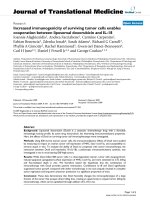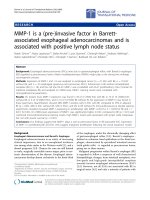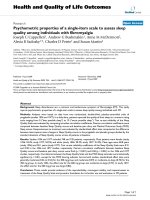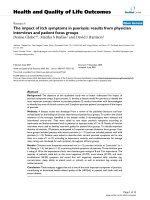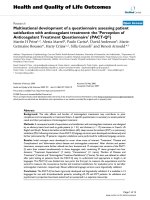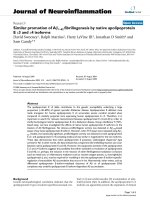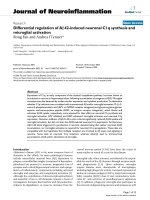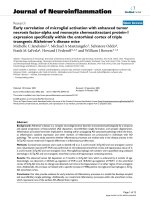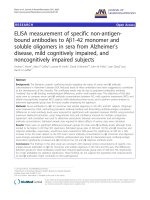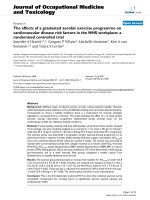báo cáo hóa học: " Similar promotion of Aβ1-42 fibrillogenesis by native apolipoprotein E ε3 and ε4 isoforms" pptx
Bạn đang xem bản rút gọn của tài liệu. Xem và tải ngay bản đầy đủ của tài liệu tại đây (218.7 KB, 4 trang )
BioMed Central
Page 1 of 4
(page number not for citation purposes)
Journal of Neuroinflammation
Open Access
Research
Similar promotion of Aβ
1-42
fibrillogenesis by native apolipoprotein
E ε3 and ε4 isoforms
David Sweeney
1
, Ralph Martins
2
, Harry LeVine III
3
, Jonathan D Smith
4
and
Sam Gandy*
5
Address:
1
Cornell University Medical College, 1300 York Ave, Room A569, New York, NY 10021 USA,
2
Sir James McCusker Alzheimer's Unit, The
University of Western Australia, Perth WA, Australia 6009,
3
Sanders-Brown Institute on Aging, University of Kentucky, Lexington, KY 40508 USA,
4
Cleveland Clinic, Cleveland, OH 44195 USA and
5
Farber Institute for Neurosciences Thomas Jefferson University 900 Walnut Street, JHN 467
Philadelphia, PA 19107-5587 USA
Email: David Sweeney - ; Ralph Martins - ; Harry LeVine - ;
Jonathan D Smith - ; Sam Gandy* -
* Corresponding author
Abstract
The apolipoprotein E ε4 allele contributes to the genetic susceptibility underlying a large
proportion (~40–60%) of typical, sporadic Alzheimer disease. Apolipoprotein E deficient mice
made transgenic for human apolipoprotein E ε4 accumulate excess cerebral amyloid when
compared to similarly prepared mice expressing human apolipoprotein E ε3. Therefore, it is
important to search for relevant interactions(s) between apolipoprotein E ε4 and Aβ in order to
clarify the biological role for apolipoprotein E ε4 in Alzheimer disease. Using a thioflavine T (ThT)-
based assay, we have investigated the effects of native human apolipoprotein E isoforms on the
kinetics of Aβ fibrillogenesis. No obvious profibrillogenic activity was detected in Aβ
1-40
-based
assays of any native apolipoprotein E isoform. However, when ThT assays were repeated using Aβ
1-
42
, modest, but statistically significant, profibrillogenic activity was detected in both apolipoprotein
E ε3- and apolipoprotein E ε4-containing media and was similar in magnitude for the two isoforms.
These data demonstrate that native apolipoprotein E possesses "pathological chaperone"-type
activity for Aβ: in other words, the data indicate that a chaperone-like misfolding reaction can occur
between native apolipoprotein E and Aβ. However, the equipotent activities of the apolipoprotein
E ε3 and ε4 isoforms suggests the possibility that either extended co-incubation of apolipoprotein
E and Aβ, or, perhaps, the inclusion in the reaction of other fibrillogenesis-modulation co-factors
(such as metal ions, or inflammatory mediators such as reactive oxygen species, α
2
-macroglobulin,
apolipoprotein J, etc.) may be required for modeling in vitro the apolipoprotein E-isoform-specific-
regulation of extracellular Aβ accumulation that occurs in vivo. Alternatively, other events, such as
differential apolipoprotein E-isoform-mediated clearance of Aβ or of apolipoprotein E/Aβ
complexes may underlie apolipoprotein E-isoform-dependent Aβ accumulation.
Background
Genetic-neuropathological correlation indicates that the
apolipoprotein E type ε4 isoform specifies increased cere-
bral [1,2] and cerebrovascular [3] accumulation of amy-
loid β-protein (Aβ). In addition, the apolipoprotein E ε2
isoform can apparently prevent the expression of clinical
Published: 16 August 2004
Journal of Neuroinflammation 2004, 1:15 doi:10.1186/1742-2094-1-15
Received: 07 August 2004
Accepted: 16 August 2004
This article is available from: />© 2004 Sweeney et al; licensee BioMed Central Ltd.
This is an open-access article distributed under the terms of the Creative Commons Attribution License ( />),
which permits unrestricted use, distribution, and reproduction in any medium, provided the original work is properly cited.
Journal of Neuroinflammation 2004, 1:15 />Page 2 of 4
(page number not for citation purposes)
Alzheimer-type dementia which is otherwise typically
associated with amyloidogenic mutations in the amyloid-
β protein precursor [4]. Since the apolipoprotein E ε4
allele contributes to the genetic susceptibility underlying
a large proportion (~40–60%) of typical, sporadic Alzhe-
imer disease, it is important to search for relevant interac-
tions(s) between apolipoprotein E ε4 and Aβ in order to
clarify the biological role for apolipoprotein E ε4 in Alzhe-
imer disease. Currently proposed mechanisms include
differential activities of apolipoprotein E isoforms in
modulating Aβ fibrillogenesis [5-7] and/or Aβ clearance
[8,9]. Many studies of apolipoprotein E modulation of Aβ
fibrillogenesis have utilized denatured apolipoprotein E,
purified from the serum of human apolipoprotein E
homozgotes following extraction in organic solvents [10].
While providing a convenient source of pure apolipopro-
tein E protein, this preparation does not represent native
apolipoprotein E as it exists in vivo. Using a thioflavine T
(ThT)-based assay [11] we have investigated the effects of
native human apolipoprotein E isoforms on the kinetics
of Aβ fibrillogenesis.
Methods
Synthetic Aβ
1-40
or Aβ
1-42
(Keck Foundation Protein Facil-
ity, Yale University, New Haven CT) was freshly prepared
for each assay at a concentration of 16 mg/ml in distilled,
deionized water and diluted with phosphate-buffered
saline (PBS) to generate a 5 mg/ml working solution. The
"aggregation step" consisted of a reaction mixture con-
taining 8 µl Aβ peptide (1 mg/ml final conc) and 32 µl of
either apolipoprotein E ε3- or ε4-containing conditioned
medium or control conditioned medium from SV40
empty vector-transfected cells.
For the investigation of native apolipoprotein E prepara-
tions, apolipoprotein E isoforms were generated in the
conditioned medium of stably-transfected SV40-apolipo-
protein E ε3-, or SV40-apolipoprotein E ε4-, expressing
Chinese hamster ovary (CHO) cells (CHO cells lack
detectable endogenous apolipoprotein E; data not
shown). All conditioned media were prepared using Dul-
becco's minimal essential medium supplemented with
0.2% (wt/vol) bovine serum albumin only (no fetal
bovine serum). Apolipoprotein E isoform levels were
determined by quantitative immunoblotting of condi-
tioned medium and apolipoprotein E-containing serum
standards, the latter having been kindly provided by Dr.
Petar Alaupovic of the Oklahoma Medical Research Foun-
dation (Oklahoma City OK). Conditioned medium apol-
ipoprotein E concentrations were then standardized using
control medium conditioned by SV40 empty vector-trans-
fected cells as diluent, yielding a final concentration of
apolipoprotein E of 14 µg/ml, within the range of that
reported in human cerebrospinal fluid. Since the final
concentration of Aβ peptide was 1 mg/ml, the Aβ/apoli-
poprotein E stoichiometry (molar ratio) was ~500:1, sug-
gesting models for the Aβ/apolipoprotein E interaction
based either on a "catalytic" "pathological chaperoning"
model of apolipoprotein E action on Aβ, or with a "seed-
ing" model of Aβ folding. Detailed biochemical character-
ization of this native apolipoprotein E preparation has
been reported [9].
The "aggregation step" fibrillogenesis reaction [11] was
incubated at 37°C until the time of the ThT fluorescence
measurement, which was performed from 1 to 7 days
later. For the "measurement step" [11], 960 µ1 of 10 µM
ThT (Nakarai Chemicals, Kyoto, Japan) in 50 mM phos-
phate buffer (pH 6.0) was added to the "aggregation step"
reaction mixture. Within 30 minutes after addition of
ThT, fluorescence was measured with a Millipore
Cytofluor (Bedford MA) in each of five successive 200 µl
aliquots of the reaction mixture, using an excitation filter
of 450 nm and an emission filter of 482 nm, and a tem-
perature of 25°C.
In order to standardize the ThT assay in our Laboratory,
we performed studies of Aβ fibrillogenesis following 1–7
day incubations of Aβ
1-40
, either in physiological phos-
phate buffer alone or in the presence of metal ions (Zn
2+
,
Fe
2+
, or A1
3+
; 1 mM final conc [12]. ThT fluorescence and
ultrastructural features were measured daily (not shown).
Profibrillogenic activities of the metal ions tested were in
agreement with a published report [12] (e.g., Al
3+
stimu-
lated ThT fluorescence of Aβ
1-40
by 3.6 ± 1.1- to 5.7 ± 1.4-
fold; p < 0.01), indicating that our Aβ preparations were
capable of metal ion-induced fibrillogenesis. Metals were
not present during assessment of profibrillogenic effects
of apolipoprotein E isoforms.
Results and discussion
No obvious profibrillogenic activity was detected in Aβ
1-
40
-based assays of any native apolipoprotein E isoform
(Table 1). However, when ThT assays were repeated using
Aβ
1-42
, modest, but statistically significant, profibrillo-
genic activity was detected in both apolipoprotein E ε3-
and apolipoprotein E ε4-containing media and was simi-
lar in magnitude for the two isoforms (Table 1). The
observation of a profibrillogenic effect of apolipoprotein
E specifically for Aβ
1-42
has been noted [5] and is of partic-
ular interest in light of biophysical and molecular neu-
ropathological evidence suggesting that "long" Aβ
peptides ending at positions N-42 or N-43 are apparently
crucial for the initiation ("seeding") of Aβ deposition
[13].
These data demonstrate that native apolipoprotein E pos-
sesses "pathological chaperone"-type activity for Aβ: in
other words, the data indicate that a chaperone-like mis-
folding reaction can occur between native apolipoprotein
Journal of Neuroinflammation 2004, 1:15 />Page 3 of 4
(page number not for citation purposes)
E and Aβ, at least at the concentrations and proportions
evaluated herein. However, the equipotent activities of
the apolipoprotein E ε3 and ε4 isoforms suggests the pos-
sibility that either extended co-incubation of apolipopro-
tein E and Aβ, or, perhaps, the inclusion in the reaction of
other fibrillogenesis-modulation co-factors (such as metal
ions, or inflammatory mediators such as reactive oxygen
species, α
1
-antichymotrypsin, heparin sulfate-protcogly-
can, non-Aβ component, apolipoprotein J, complement,
etc.) may be required for modeling in vitro the apolipo-
protein E-isoform-specific-regulation of extracellular Aβ
accumulation that occurs in vivo.
Alternatively, other events, such as differential apolipo-
protein E-isoform-mediated clearance of Aβ or of apolipo-
protein E/Aβ complexes [8,9,14] may contribute to
apolipoprotein E-isoform-dependent Aβ accumulation.
Differential anti-inflammatory activity might also play a
role. Further investigation will be required in order to elu-
cidate the precise mechanism(s) which specify how apol-
ipoprotein E ε4 promotes Aβ accumulation in human
brain and cerebral vessels in vivo.
List of abbreviations
ThT, thioflavine T; Aβ, amyloid-β peptide; PBS, phos-
phate-buffered saline; CHO, Chinese hamster ovary cells.
Competing interests
None declared.
Authors' contributions
DS performed all assays, including the ThT assay, which
was originated by HL. HL also oversaw the transfer of the
assay from his lab to ours. RM prepared standard condi-
tioned media from transfected cells provided by JDS. SG
oversaw the project, supported the project as noted below,
and wrote the manuscript.
Acknowledgements
This research was supported by USPHS PPG grant AG10491 to S.G. We
thank Jan Naslund and Christer Nordstedt (Karolinska Institute, Stock-
holm, Sweden) for critical comments and helpful discussion.
References
1. Schmechel DE, Saunders AM, Strittmatter WJ, Crain BJ, Hulette CM,
Joo SH, Pelicak-Vance MA, Goldgaber D, Roses AD: Increased
amyloid β-peptide deposition in cerebral cortex as a conse-
quence of apolipoprotein E genotype in late-onset Alzhe-
imer disease. Proc Natl Acad Sci USA 1993, 90:9649-9653.
2. Holtzman D, Bales K, Tenkova T, Fagan A, Parsadanian M, Sartorius
L, Mackey B, Olney J, McKeel D, Wozniak D, Paul S: Apolipoprotein
E isoform-dependent amyloid deposition and neuritic degen-
eration in a mouse model of Alzheimer's disease. Proc Natl
Acad Sci USA 2000, 97:2892-2897.
3. Greenberg SM, Rebeck GW, Vonsattel JPG, Gomez-Isla , Hyman BT:
Apolipoprotein E ε4 and cerebral hemorrhage associated
with amyloid angiopathy. Ann Neurol 1995, 38:254-259.
4. St George-Hyslop P, Crapper McLachlan D, Tuda T, Rogaev E, Kar-
linsky H, Lippa CF, Pollen D: Alzheimer's disease and possible
gene interaction. Science 1994, 263:537.
5. Ma J, Yee A, Brewer HB, Das S, Potter H: Amyloid-associated pro-
teins α
1
-antichymotrypsin and apolipoprotein E promote
assembly of Alzheimer β-protein into filaments. Nature 1994,
372:92-94.
6. Wisniewski T, Castano EM, Golabek A, Vogel T, Frangione B: Accel-
eration of Alzheimer's fibril formation by apolipoprotein E in
vitro. Am J Pathol 1994, 145:1030-1035.
7. Evans KC, Berger EP, Cho C-G, Weisgraber KH, Lansbury PT: Apol-
ipoprotein E is a kinetic but not a thermodynamic inhibitor
of amyloid formation: Implications for the pathogenesis and
treatment of Alzheimer's disease. Proc Natl Acad Sci USA 1995,
92:763-767.
8. LaDu M, Falduto M, Manelli A, Reardon C, Getz C, Frail D: Isoform-
specific binding of apolipoprotein E to β amyloid. J Biol Chem
1994, 269:23403-23406.
9. Zhou Z, Smith JD, Greengard P, Gandy S: Alzheimer amyloid-β
peptide forms denaturant-resistant complex with type ε3
but not type ε4 isoform of native apolipoprotein E. Molecular
Medicine 1996, 2:175-180.
10. Rail SC, Weisgraber KH, Mahley RW: Isolation and characteriza-
tion of apolipoprotein E. Meth Enzymol 1986, 128:273-287.
11. LeVine H: Thioflavine T interaction with synthetic Alzhe-
imer's disease β-amyloid peptides: Detection of amyloid
aggregation in solution. Protein Science 1993, 2:404-410.
12. Mantyh P, Ghilardi J, Rogers S, DeMaster E, Allen C, Stimson E, Mag-
gio J: Aluminum, iron and zinc ions promote aggregation of
physiological concentration of β-amyloid peptide. J Neurochem
1993, 61:1171-1174.
Table 1: Effects of native apolipoprotein E isoforms on fibrillogenesis of Aβ
1-40
and Aβ
1-42
. Fold-effects represent means ± SEM of the
quotients of ThT fluorescence values obtained for each Aβ peptide in the presence of apolipoprotein E-isoform-containing conditioned
medium divided by ThT values obtained in the presence of conditioned medium lacking apolipoprotein E, derived from empty vector-
transfected cells (n = 5–6).
Aβ
1-40
1 day co-incubation CHO apolipoprotein E ε3 1.0 ± 0.l-fold N.S.
CHO apolipoprotein E ε4 1.0 ± 0.l-fold N.S.
7 day co-incubation
CHO apolipoprotein E ε3 1.0 ± 0.l-fold N.S.
CHO apolipoprotein E ε4 1.2 ± 0.l-fold N.S.
Aβ
1-42
4 day co-incubation CHO apolipoprotein E ε3 1.7 ± 0.27-fold p < 0.01
CHO apolipoprotein E ε4 1.6 ± 0.18-fold p < 0.005
7 day co-incubation
CHO apolipoprotein E ε3 1.7 ± 0.22-fold p < 0.005
CHO apolipoprotein E ε4 1.8 ± 0.19-fold p < 0.0005
Publish with Bio Med Central and every
scientist can read your work free of charge
"BioMed Central will be the most significant development for
disseminating the results of biomedical research in our lifetime."
Sir Paul Nurse, Cancer Research UK
Your research papers will be:
available free of charge to the entire biomedical community
peer reviewed and published immediately upon acceptance
cited in PubMed and archived on PubMed Central
yours — you keep the copyright
Submit your manuscript here:
/>BioMedcentral
Journal of Neuroinflammation 2004, 1:15 />Page 4 of 4
(page number not for citation purposes)
13. Iwatsubo T, Odaka , Suzuki N, Mizusawa H, Nukina N, Ihara Y: Visu-
alization of Aβ 42(43) and Aβ40 in senile plaques with end-
specific Af3 monoclonals: Evidence that an initially deposited
species is Aβ42(43). Neuron 1994, 13:45-53.
14. Naslund J, Thyberg J, Tjemberg L, Wemstedt C, Karlstrom AR,
Bogdanovic N, Gandy S, Lannfelt L, Terenius L, Nordstedt C: Char-
acterization of stable complexes involving apolipoprotein E
and the amyloid β-peptide in Alzheimer disease brain. Neuron
1995, 15:219-228.
